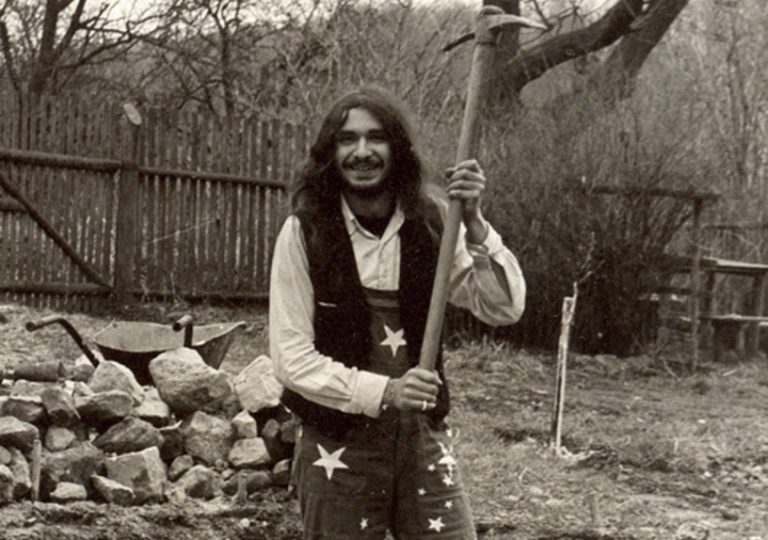This February, filmmaker, musician, translator, graphic artist and man of many talents and occupations Lubomír Drožď, nicknamed Čaroděj OZ (The Wizard of OZ), died unexpectedly. Drožď belonged to the generation of the New Wave of Underground of the 1980s and as a filmmaker, he largely defined the rules of underground film. Although he made more than twenty films between 1979-1986, they remain largely unknown. He wanted underground film to be separated from the official structures and made his films in a closed community much like many other filmmakers at that time. Čaroděj’s work proved that personal is at the same time political. The space of his films was defined by authentic experiences of people surrounding him, their lives, conflicts with the authorities but also humour, fantasies and dreams. Many of his films are set around his house in Ždírec near the Kokořín castle where he went to self-imposed exile in the 1970s with his partnerdirector Irena Gosmanová nicknamed Pigi.
The era in which Čaroděj started making his films was far from favourable. He not only found himself relatively isolated on the edge of the society but his work also coincided with the crisis of experimental film which definitively rejected the formalist doctrine of the 1960s that had managed to seize control of academic positions. The last place that remained free in the 1980s was personal life. All around the world emerged local film collectives, communities and subcultures sharing one thing – they existed only in a limited time and space and never managed to establish themselves as artistic trends. They didn’t even strive to do that. Čaroděj, whose work is a parallel to Berlin post-punk, Dresden Super-8, New York no-wave cinema and Moscow parallel cinema, dealt with this dilemma during the period of Normalisation in a radical manner – his films deliberately don’t have any artistic content and ambitions to achieve high aesthetics and in turn become part of the world of art. He was content with the world he created with the people surrounding him. In their centre lies the matter of authenticity, truthfulness and the necessity to represent the values of a community excluded by the world – which sounds as an ideal requirement even today. His heroes are distinct individualities in a conflict with their surroundings, they look for freedom in tangle of rules in defiance of ignorant and lethargic society. Let us name at lease some of them – a surreal dystopia in the centre of Normalisation titled The Temptation of St. Antonius or An Old Master’s Weekend (Pokušení sv. Antonína anebo víkend starého mistra, 1984), Orwellian adaptation set at Letná 1984 (1984), comical travesty Queen of China Town (1981) and anti-war tragicomedy Eye After an Eye, Tooth After a Tooth (Voko za vokem, zub za zubem, 1985).
Looking at Čaroděj’s film, it’s apparent that he made fun of failing socialism. He parodied and caricatured social rituals and portrayed them in a tragicomically absurd way. After all, his nickname OZ are the initials of the National Company Ovoce and Zelenina (Fruit and Vegetables).
During the joyful years right after the Velvet Revolution, not many people wanted to revisit the traumas of the Normalisation era so his films were soon forgotten. The fate of authentic community movements is their slow expiration. But Čaroděj never built his cultural capital on the dissent’s moral sentiments as the previous generation succesfuly managed. When the post-punk wave subsided in the late 1980s, he was one of the few filmmakers able to use similar sarcasm to comment the world of the 1990s. Adopting a new nickname, Blumfeld S. M., he successfully continued caricaturing the emerging capitalism. Soon, he discovered the method of cultural appropriation, a hybrid of neo-dada and pop-art in a time when the internet was still new. The genre, sometimes called avant-pop, combined cultural sarcasm, dystopia, cyberpunk with the endless possibilities of digital collage (its most famous proponents include Mark Amerika whose hypertext novel Grammatron is set in Prague). In his following activities, Čaroděj abandoned film and threw himself into writing. He published a collection of short stories titled Peep Show (2001), commented his creative methods in the Czech Television and as an editor took the underground magazine Vokno to the new millennium. Thanks to his work, the magazine remained one of the very few 80s periodicals attractive to younger generations. His unbiased perspective and knowledge came in handy in many translations he made – from various cyberpunk and horror texts to spiritual literature to Bauman’s Liquid Modernity.
Some ten years ago, he opened his film archive again. As the interest in the period of late socialism (and the world before internet) increased, marginalised communities found themselves in the spotlight. Čaroděj’s films were digitally restored and screened at festival both at home and abroad. He mostly remained calm, stayed at home in Ždírec and refused to visit the festivals. But he took great care of digitising his films including the reconstruction of many unique screening methods and live sound manipulation. The collection of his work and its digitally restored versions created thanks to the initiative of the Centre for Audiovisual Studies are now stored in the National Film Archive. Despite the renewed wave of interest, it still remains unclear whether the distinct culture of the ending pre-digital world was understood and if there is something to learn form it. Just like the films of his peers Nick Cop, Via Lewandowski, Igor Aleynikov and other, his works looks suspiciously imperfect, locally and appealing to small groups of audience equipped with pre-understanding. They’re not big films for global audience. But perhaps this is the quality that the contemporary experimental film lacks due to the required internationalisation, marketing and global and on-line festival distribution. But sometimes it’s more important to address the people surrounding you.
Martin Blažíček
Author heads the Centre for Audiovisual Studies at the Film and TV School of the Academy of Performing Arts in Prague

